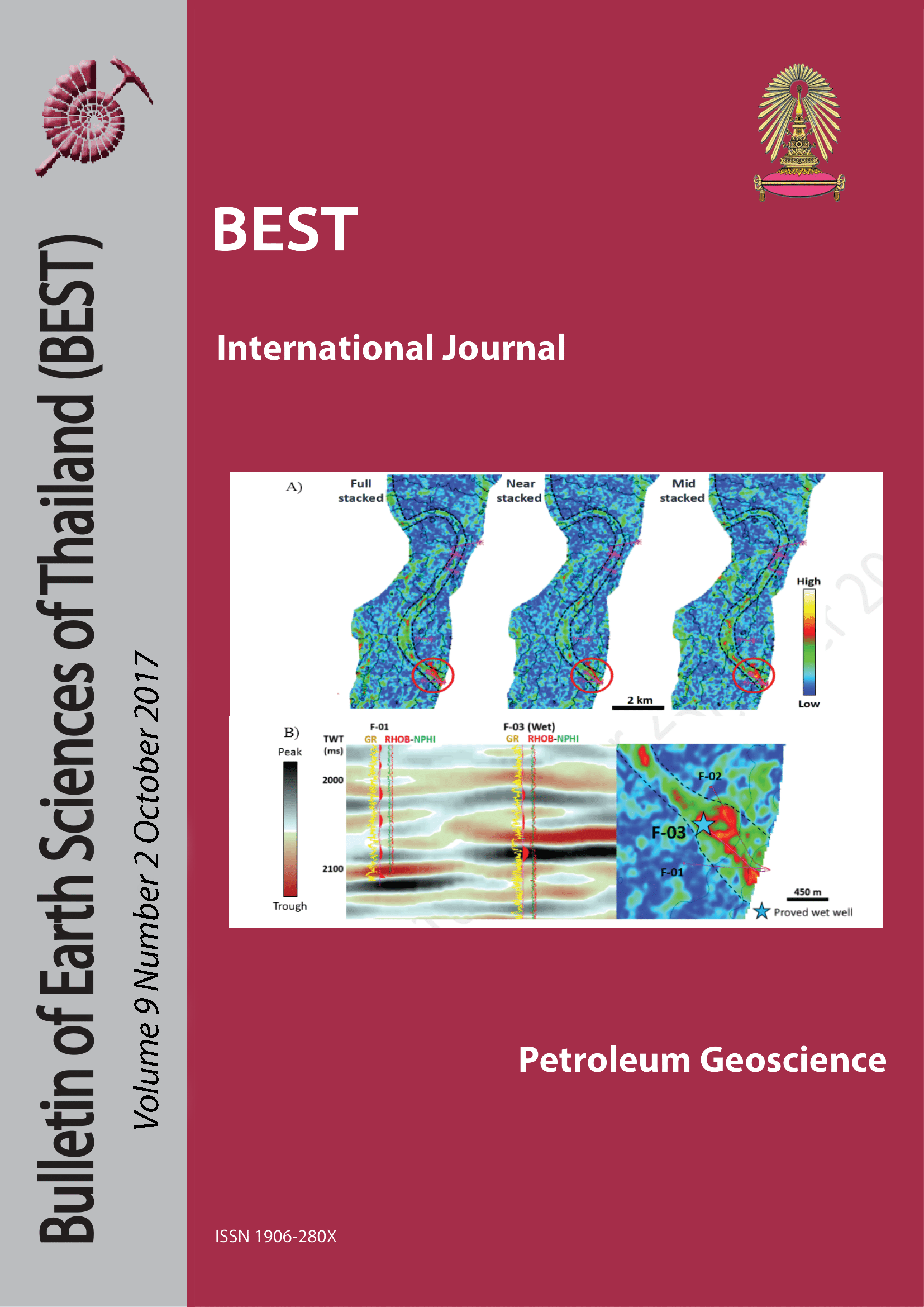CONTROLS ON POROSITY IN SANDSTONE RESERVOIRS IN SOUTHERN PATTANI BASIN, GULF OFTHAILAND
Main Article Content
Abstract
The reservoir rock in southern Pattani Basin, Gulf of Thailand is sandstone, which was deposited in various environments from fluvial to marginal marine. This study integrated conventional core, side-wall core, wireline data, and petrographic data to recognize and better understand the factors that control porosity in this area. The porosity can be divided into 3 zones (west, central and east). The west and east zones has one porosity trend, but the central zone has two porosity trends, which has the increased porosity shift in the lower reservoir section. The central zone has better reservoir quality in the lower section than the others. The nearby fields also have two porosity trends. Compaction, clay content, and cementation are the major influences on porosity in this area, while lithology, composition, sorting, and dissolution have less impact. Dissolution enhances porosity while the others destroy porosity. Dissolution pores are normally filled or partially filled with authigenic clay. The two porosity trends in this area are probably caused by different cement agents in the upper and lower sections
Article Details

This work is licensed under a Creative Commons Attribution-NonCommercial-NoDerivatives 4.0 International License.
Copyright © 2008 Department of Geology, Faculty of Science, Chulalongkorn University. Parts of an article can be photocopied or reproduced without prior written permission from the author(s), but due acknowledgments should be stated or cited accordingly.
References
Athy, L. F., 1930, Density, porosity, and compaction of sedimentary rocks: AAPG Bulletin, 14 (1), p. 1-24.
Crossley, A. R., 1990, The geological and hydrocarbon potential of the Pattani Basin, Gulf of Thailand-An overview: Unocal Thailand Internal Report, November 1990, 99 p.
David K. Davies & Associates, Inc., 1992, Thin section, X-ray diffraction and scanning electron microscope analyses: MioceneOligocene sandstone Ubon No.1 well, Gulf of Thailand.
Folk, R. L., 1974, Petrology of Sedimentary Rocks: Hemphill Publishing Company, Austin, Texas, 182 p.
Juntra, W., 2003, Reservoir characterization from core to wireline calibration and petrography based on well Ubon-02, Ubon field, Gulf of Thailand, Master’s thesis, University Brunei Darussalam, Brunei, 139p.
Pettijohn, F. J., 1975, Sedimentary rocks, 3rd ed.: New York, Harper and Row, p. 628
Praiwan, U., 2015, Diagenesis and porosityreducing mechanisms in Moregot field, Pattani Basin, Gulf of Thailand, Master’s thesis, Chulalongkorn University, Thailand, 69p
Scherer, M., 1987, Parameters influencing porosity in sandstones: a model for sandstone porosity prediction: AAPG Bulletin, vol. 71, no. 5, p. 485–491.
Taylor, T. R., Giles M. R., Hathon L. A., Diggs T. N., Braunsdorf N. R. et al., 2010, Sandstone diagenesis and reservoir quality prediction: models, myths, and reality: AAPG Bulletin 94, p. 1093-1132.
Willamette Geological Service, 1996, Reservoir Characterization of Sequence 1 and Sequence 2 Sandstones, Ubon-02 well, Gulf of Thailand.
Wilson, M. D., and Pittman, E. D., 1997, Authigenic clays in sandstones : recognition and influence on reservoir properties and paleaoenvironment analysis: J. sedim. Petrol. 47, p. 3-31.
Core Laboratories, 1996, Advanced rock properties report, Ubon-02 well, Gulf of Thailand.


